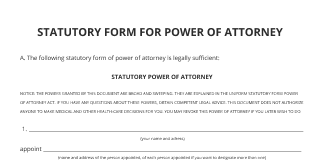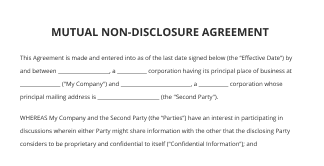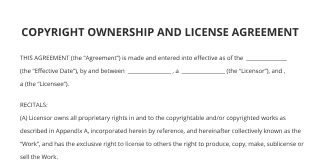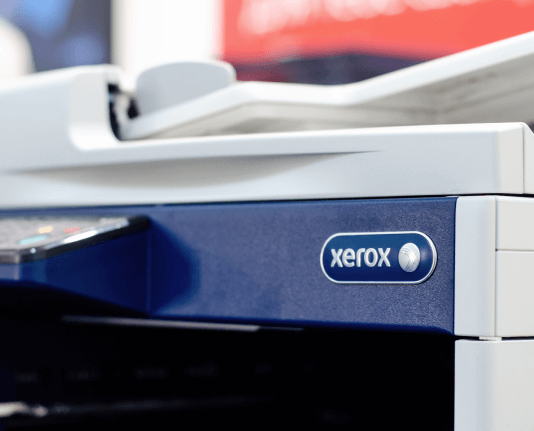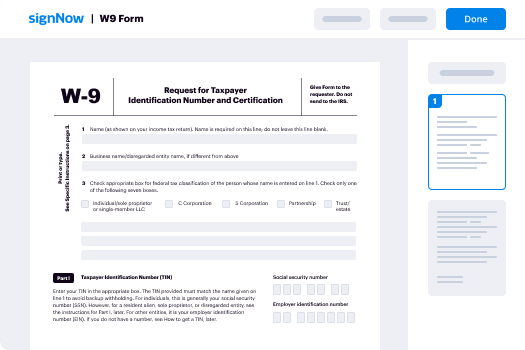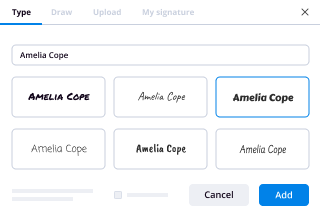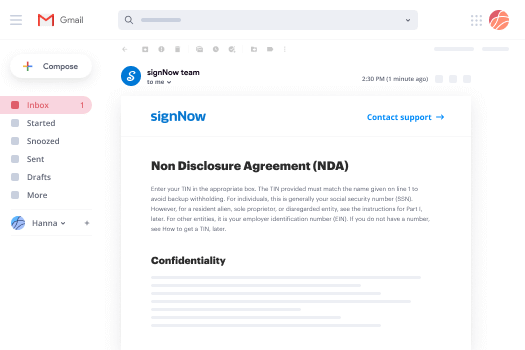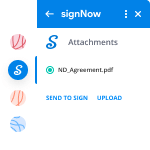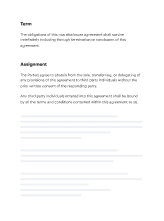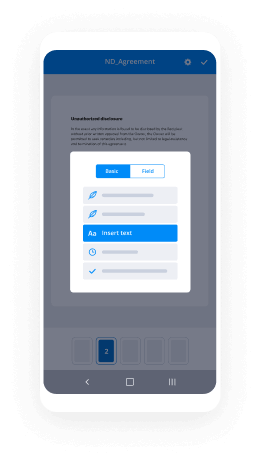Modèle De Convention De Licenciement Simplifié
Obtenez les fonctionnalités puissantes de eSignature dont vous avez besoin de la solution en laquelle vous avez confiance
Sélectionnez la plateforme professionnelle conçue pour les professionnels
Configurez rapidement l'API eSignature
Collaborez mieux ensemble
Modèle de convention de licenciement en quelques minutes
Réduisez le délai de clôture
Maintenez les données importantes en sécurité
Découvrez les signatures électroniques airSlate SignNow en action
Solutions airSlate SignNow pour une meilleure efficacité
Les avis de nos utilisateurs parlent d'eux-mêmes






Pourquoi choisir airSlate SignNow
-
Essai gratuit de 7 jours. Choisissez le forfait dont vous avez besoin et essayez-le sans risque.
-
Tarification honnête pour des forfaits complets. airSlate SignNow propose des abonnements sans frais supplémentaires ni frais cachés lors du renouvellement.
-
Sécurité de niveau entreprise. airSlate SignNow vous aide à respecter les normes de sécurité mondiales.

Votre guide étape par étape — mark severance agreement template
En utilisant la signature électronique d'airSlate SignNow, toute entreprise peut augmenter ses flux de signature et signer électroniquement en temps réel, offrant une meilleure expérience aux clients et aux employés. Utilisez le modèle de convention de licenciement en quelques étapes simples. Nos applications mobiles rendent le travail en déplacement possible, même hors ligne! Signez depuis n'importe où dans le monde et terminez les tâches plus rapidement.
Comment remplir et signer un mark severance agreement template
- Connectez-vous à votre compte airSlate SignNow.
- Trouvez votre document dans vos dossiers ou importez-en un nouveau.
- Ouvrez le modèle en utilisant la liste Outils.
- Déposez des champs remplissables, ajoutez du texte et signez-le électroniquement.
- Ajoutez plusieurs signataires par e-mails et définissez l'ordre de signature.
- Choisissez quels destinataires peuvent recevoir une version signée.
- Utilisez Options Avancées pour limiter l'accès au document et définir une date d'expiration.
- Cliquez sur Enregistrer et Fermer une fois terminé.
De plus, il existe des fonctionnalités plus avancées pour le modèle de convention de licenciement. Ajoutez des utilisateurs à votre environnement de travail partagé, visualisez les équipes et suivez le travail d'équipe. Des millions d'utilisateurs aux États-Unis et en Europe conviennent qu'une solution qui rassemble les gens dans un seul endroit numérique cohérent est exactement ce dont les organisations ont besoin pour faire fonctionner facilement leurs flux de travail. L'API REST d'airSlate SignNow vous permet d'intégrer les signatures électroniques dans votre application, site web, CRM ou stockage cloud. Découvrez airSlate SignNow et obtenez des flux de signature électronique plus rapides, plus simples et globalement plus productifs!
Comment ça marche
Fonctionnalités airSlate SignNow appréciées par les utilisateurs
Découvrez des résultats exceptionnels mark severance agreement template
Obtenez des signatures juridiquement contraignantes dès maintenant !
FAQ mark severance agreement template
-
Comment rédiger une convention de licenciement?
Détails de la compensation. Règles de confidentialité après la résiliation. Date de la fin de l'emploi. Accord des deux parties sous forme de signature. Détails sur la durée pendant laquelle l'employé continuera à avoir accès aux avantages. -
Quel est le package de licenciement typique?
La indemnité de licenciement offerte est généralement d'une à deux semaines pour chaque année travaillé mais peut être plus. Si la perte d'emploi crée une difficulté économique, discutez-en avec votre ancien employeur. La pratique générale est d'essayer d'obtenir quatre semaines de paiement de licenciement pour chaque année travaillé. -
Peut-on demander une indemnité de licenciement si on démissionne?
Démissionner vous laisse avec très peu d'options. Vous n'aurez pas de salaire pendant que vous cherchez un nouvel emploi. Votre employeur ne vous versera pas d'indemnité de licenciement et vous serez généralement inéligible à l'assurance chômage. ... Vous avez décidé que quitter votre employeur actuel en démissionnant est la solution. -
Puis-je poursuivre si j'ai signé une convention de licenciement?
Si votre convention de licenciement comprenait une clause de décharge, vous avez peut-être renoncé à votre droit de poursuivre votre ancien employeur. Certains employeurs offrent une indemnité de licenciement aux employés qui perdent leur emploi. Cependant, souvent, les employés qui veulent une indemnité doivent signer une décharge ou une renonciation, par laquelle ils renoncent à leur droit de poursuivre la société. -
Dois-je accepter l'indemnité de licenciement?
Dois-tu accepter une indemnité de licenciement? La réponse courte est non. Vous n'êtes pas obligé d'accepter ce que votre employeur propose, ni de signer une décharge. Une décharge n'est valable que si elle est volontaire : si votre employeur vous oblige ou vous force à signer, elle ne sera pas maintenue en justice. -
Qu'est-ce qu'une lettre de licenciement?
Un package de licenciement est une rémunération et des avantages que les employés peuvent recevoir lorsqu'ils quittent leur emploi de manière non volontaire. ... En plus de leur salaire régulier restant, il peut inclure certains des éléments suivants : Tout paiement supplémentaire basé sur le nombre de mois de service. -
Puis-je poursuivre après avoir signé une convention de licenciement?
Si votre convention de licenciement comprenait une clause de décharge, vous avez peut-être renoncé à votre droit de poursuivre votre ancien employeur. Certains employeurs offrent une indemnité de licenciement aux employés qui perdent leur emploi. Cependant, souvent, les employés qui veulent une indemnité doivent signer une décharge ou une renonciation, par laquelle ils renoncent à leur droit de poursuivre la société. -
Que se passe-t-il si vous ne signez pas une convention de séparation?
Bien que vous n'ayez pas à signer une convention de licenciement, votre employeur peut en faire une condition pour recevoir l'indemnité de licenciement. ... Cependant, dans la plupart des cas, un employeur est libre de conditionner l'indemnité de licenciement à la signature de l'employé. En d'autres termes, si l'employé refuse de signer, il ne recevra pas d'indemnité de licenciement. -
Qu'est-ce qu'une convention de séparation confidentielle?
Pour ce faire, la plupart des entreprises utilisent une convention de séparation d'emploi. ... Les conventions de séparation d'emploi ne sont pas obligatoires par la loi ; les entreprises les utilisent pour sceller des informations confidentielles de l'entreprise ou pour se protéger contre des poursuites. Après signature, un employé ne peut pas poursuivre l'employeur pour licenciement abusif ou indemnité de licenciement. -
Peut-on signer une convention de séparation sans avocat?
La loi n'exige pas qu'une personne ait un avocat pour créer une convention de séparation. Certains conjoints, invoquant le coût, envisagent de créer leur propre convention de séparation sans avocat. ... Les conventions de séparation peuvent être assez complexes, comme vous pouvez l'imaginer. -
Que se passe-t-il après la signature d'une convention de séparation?
Faire respecter une convention de séparation Une fois que vous et votre conjoint avez signé l'accord, il devient un contrat juridiquement contraignant que vous devez respecter. Cela signifie que vous pouvez poursuivre votre conjoint ou ex-conjoint pour dommages si ils ne respectent pas l'accord et pour faire respecter ses termes. -
Dois-je signer une convention de séparation et de décharge?
Bien que vous n'ayez pas à signer une convention de licenciement, votre employeur peut en faire une condition pour recevoir l'indemnité de licenciement. ... Cependant, dans la plupart des cas, un employeur est libre de conditionner l'indemnité de licenciement à la signature de l'employé. En d'autres termes, si l'employé refuse de signer, il ne recevra pas d'indemnité de licenciement.
Ce que disent les utilisateurs actifs — mark severance agreement template
Recherches associées à mark severance agreement template
Mark severance agreement template
inside America's boardrooms the informational show for board members and corporate secretaries brought to you with knowledge partners villager's PwC Center for audit quality Spencer steward The Conference Board and corporate board members along with content contributors equal our Veridian compensation partners Wilson Sonsini Goodrich Androzani Donnelly financial solutions and the Society for corporate governance welcome to this edition of inside America's boardrooms I'm TK curse that are the CEO of boardroom resources and the co-founder and editor large of corporate board member it's my pleasure to welcome you to the show we're filming here today in the New York studios of The Conference Board and our topic today is how to structure a fair executive severance arrangement and my guest is someone who is versed in this topic and is going to help the audience understand that what to know and welcome Ryan Harvey who's a partner with Meridian compensation Partners welcome Ryan thanks TK we're gonna start very Elementary okay and I think everybody knows the answers to this but we're still gonna ask the question and that is sort of why a severance is part of the package and why it's important to the board yep yep well very often in at least in the press executive confident our executive severance arrangements can be construed as being paid for failure and there's definitely examples out there of severance arrangements which are paid for failure that kind of reinforced that stereotype but I think if they're if they're well constructed they can really support the the needs of shareholders and also can remove a lot of headaches for the board a couple of quick things I would point out that our kind of benefits of having severance of pre-established one of those is it removes the ad hoc negotiation that often goes on when you don't have severance in place so many companies that don't put severance they still they still end up providing severance to executives who terminate but then they have to rely on kind of negotiations at that they allowed and you just don't know what circumstances are gonna be present when you terminate somebody there's very often kind of adverse business conditions there can be emotions that get involved and and very often the company is trying to get the executive to agree to different things like a non-disparagement or non-compete so waiting to the eleventh hour can put you in a weird position I seen many boards where they feel pressured to make decisions that they maybe wouldn't make if they could have designed severance kind of in the light of day before they actually got to a termination so so having that in place I think can be very helpful another thing is it just adds to inconsistency if you don't have pre-established severance so if your ad hoc going out and negotiating on a case-by-case basis you can have very different severance practices between executives over time which is something you want to avoid but probably the biggest thing to mention is just it's a competitive practice over two-thirds of companies in the US now provide executive severance to their senior executives so it's it's starting to become really a standard part of a competitive package particularly if you're trying to recruit an executive externally it could be really the final piece that gets that executive comfortable with making decision to make the move yeah and that history goes way back I mean this is not severance is not anything new it's been part of the process the question is how do you get it right in a non-emotional you know so you know we sort of established that in the end it's a good thing for shareholders Arthur when somebody looks at say-on-pay which this may be a part of what are they what are the like the key design things that people are looking for that sort of make it fair sure there's a couple of different things you want to look at if you're trying to design a really a fair severance arrangement both for executives and for shareholders the key thing when you're designing severance is you want to really provide enough value to bridge that executive to the next employer and at the executive level it could take a year maybe more than a year to find a comparable job at a new employer particularly if you have a non-compete provision that's preventing you from going to a direct competitor so because of that we generally see somewhere between one to one-and-a-half times the annual cash compensation is kind of the standard severance multiple for senior executives and annual compensation is generally includes both base salary and target target annual bonus at the CEO level it's often a little bit higher than that maybe two times is not unusual but again one and a half one to one and a half is it pretty typical and generally enough to bridge them to the next employer you also will generally see the continued continuation of health and welfare benefits for the same period as you're providing severance on the company side committees really need to step back and think about what kind of restrictions they might want to place on the executive post termination pretty universally severance arrangements have a waiver of legal claims but beyond that I would generally recommend companies take a look at at least adding a non-disparagement restriction a non solicitation of employees and a non solicitation of customers and those are those three restrictions are generally enforceable across the US and they just make a lot of sense of and you don't want a disgruntled executive out there on social media disparaging the company you don't want them to be able to poach Talent and you also don't want them to steal customers so those three I think are pretty pretty solid and should really be included in really any severance arrangement the one that you really have to think a little bit more about is the non-compete they are very common so 70 percent of severance arrangements have non-compete clauses although a non-compete is not enforceable in every jurisdiction so you really have to work with legal counsel to think through whether it makes sense or not but if it is enforceable it could be a very useful tool to avoid having an exec you've got and directly compete with you post termination as you mentioned in the air answer the first question the shareholders can sometimes get have the hair of their necks stand up when they see big payouts to CEOs who have really sort of destroyed shareholder value and that's always tough to take on that so what are when we think about a compensation committee from your experience what are the biggest mistakes maybe that a that a compensation committee might make and it's negotiating this severance as part of the package bringing an executive in knowing that if you don't do it at all that's the biggest mistake sure sure there's probably two mistakes that are the biggest or the ones that can get you in the headlines one would be improperly defining the triggers of what's going to trigger severance and the other would be being overly generous with long-term incentive treatment so on the trigger side you know most severance arranged in fact almost all severance arrangements will only trigger severance well the only way you cannot trigger severance is to terminate the executive for cause so and causes is generally very narrowly defined in most executive severance arrangements you essentially have to have you know gross negligence on the part of the executive typically commission of a crime conviction of a felony for example or fraud so it's very narrow and not many companies ever exercise clause because of that but we would really recommend that the companies step back and take a look at that cause definition make sure that it's broad enough you can you can terminate the executive for you know the areas where the committee really believes they should have the ability to terminate without triggering severance so for example you know sexual harassment you should be able to terminate an executive for sexual harassment issues for violation of company's code of conduct or ethical issues so really kind of diving deep there I think is important we do see a minority of companies that go further and and incorporate performance related clauses it's not common and it is a bit of a slippery slope that you have to be careful because you could essentially define almost every involuntary termination as a termination for performance but but I think it is valuable to take a look at that and I think for some committees it might make sense particularly if committee is very reluctant to a severance plan in place because they were worried about maybe providing severance to a poor performer this can provide them with you know some discretion around when they implement it but still have the structure and the consistency of having a severance plan in place the other the other area where we see kind of the headlines very often is on treatment of long-term incentives and you know when you see these big headlines where an executive is walking away with tens of millions of dollars of value what's usually driving that value is not the cash severance it's usually because they were they were very very generous with the equity treatment and the long term incentive treatment and so I would I generally would recommend do not fully vest long term incentives and five and we kind of fully pay out long term incentives at the time of termination those are meant to cover multiple years of service by the executive if you pay them all out at termination it's more than likely gonna be an excessive amount of value so generally some sort of proration is probably the right answer although many companies actually forfeit LTI is not uncommon but I think probably the fairest treatment is some sort of proration based on the the performance that the executive is actually provided with the company and if it is performance based the the fairest treatment is likely to wait until the end of the performance period and actually base the proration on actual performance so you do have to wait a bit if you do that but it is I think it's fair to these executive and fair to the company to do it that way I would imagine that any investigative reporter though even if something spread out as doing their own math and adding up if they can then find that information but I agree with you I think that's a that's a wise plan because if if not you know it's it's nice to keep the headlines a reasonable sure sure for that so well Ryan this is there's some great advice in this I want to thank you for taking the time to join us today and we're really covered quite a specific topic we're just looking at the severance but hopefully over time we'll try and pick apart all the issues that a comp committee has to deal with but this is certainly one and an important one so I want to thank you for taking the time great thanks for having me and that will conclude this edition of inside America's boardrooms we hope you enjoyed the show we'll be back again next week when we take another look at a critical topic that will help you be a better board member or committee member silicium join us again next week for inside America's boardroom brought to you with knowledge partners diligent PwC Center for audit quality Spencer Stewart the conference pool and corporate board members along with content contributors equilon with Ian compensation partners Wilson Sonsini good Rajendra's aunty Donnelly to Metro solutions and the Society for corporate governance [Music]
Show more




